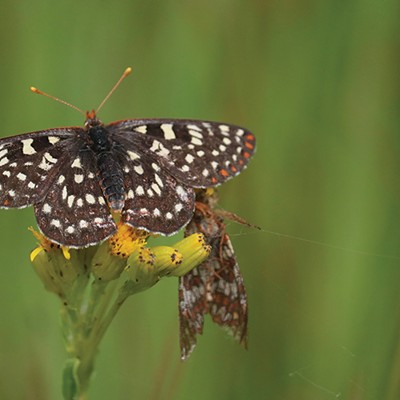This is a pest that can be looked at in several ways. For one, they have been here long before us, and no matter how many colonies you kill, they will still be here after we've gone out among the stars-they may be pests, and not much fun to look at, but they are survivors. On top of that, they are one of the favored targets of tachinid flies, helpful insect parasites that are always looking for a delicious host. Most often, if you spray tent caterpillars, you will also kill the "Good Guys." Another point is, as adults, tent caterpillars take to the wing as moths that are the favored prey for a number of bats, nighthawks, Flammulated Owls and other night-time insect feeders.
In the short-term view, tent caterpillars may seem repulsive and cause damage to plants, but in the long run-which is how Nature looks at things-they ain't so bad.
The other side of the story is that tent caterpillars don't know when to stop eating and do considerable damage. (That is, if defoliation can be construed as "damage" - some plants require that once in a while.) Most people who call me about tent caterpillars aren't very happy about them eating bitterbrush, fruit trees, or treasured ornamentals around their home; they want them gone. Period!
If you're in that group, the best way to deal with the caterpillar "problem" is to do it mechanically, not chemically. One method is to look for egg masses before they hatch and mash them into a pulp, but that takes time and you may overlook one or two, as they blend in rather well with twigs. Besides, it's too late to do that this season, as the eggs have already hatched.
Following egg mass destruction, the next best action is to remove them from the plant when you first see the "tent" and hatchling caterpillars. Use pruning shears to remove the twigs supporting the tent. (It's really a silken "mat" or "nest," but for all practical purposes we'll use "tent.")
Pay Attention now: The best time to conduct the removal process is early morning, or at night, when all the caterpillars are on, in and around the tent. When those insects follow their silken trails back to where their home used to be, they'll just get busy and build a new tent/nest and you'll have to do it all over again.
Once removed from the host plant, the easiest method of destroying the colony is to burn it, but do not use gasoline. The Fourth of July is another month away. Place the tent on a sheet of newspaper, crumple it up and pour a tablespoon of solvent (or paint-thinner) over the newspaper. Crumple another piece of newspaper on top, put it in a metal bucket away from dry brush, grass and structures, and light it. I say again... do not use gasoline! If you keep a fire extinguisher handy, it will make everyone feel better. If, however, you find a better way (or burn your house down) send me an e-mail. ([email protected])
The philosophy of tolerance for tent caterpillars is the same as with those beautiful orb weavers who are setting up shop outside your bedroom, living room and kitchen windows. Sure, they leave behind messy silk and lots of dead, sucked-dry bodies, but remember the delightful book by E. B. White, Charlotte's Web? It's an award-winning children's novel with illustrations by Garth Williams about a pig named Wilbur who is saved from slaughter by an intelligent spider named Charlotte.
Charlotte writes silken messages in her web, praising Wilbur (such as "some pig") in order to persuade the farmer to let him live. But more importantly, she is capturing and eating pestiferous flies, moths and other insects that infest their barn home.
All-every blessed one-of the Charlottes building their snares around your home is a start-up pest control service. By the end of their short but glorious life in October, they will have consumed thousands of harmful, pestiferous, disease-carrying insects, and among them will be hundreds of adult tent caterpillars. Give Old Dame Nature a chance, Oh, Best Beloved; in the long run she is really on "our side."






















